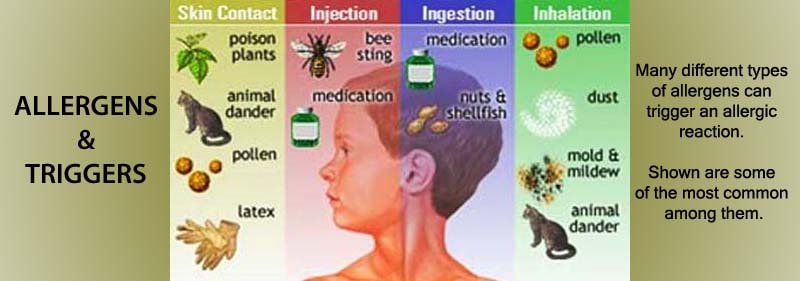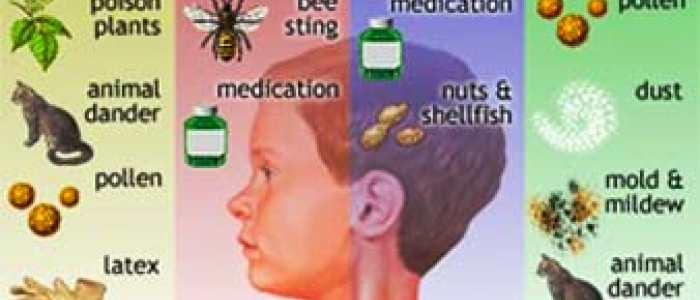
Allergies occur when the body's immune system reacts to a particular substance as though it's harmful. It's not clear why this happens, but most people affected have a family history of allergies or have closely related conditions, such as asthma or eczema. The number of people with allergies is increasing every year. The reasons for this are not understood, but 1 of the main theories is it's the result of living in a cleaner, germ-free environment, which reduces the number of germs our immune system has to deal with. It's thought this may cause it to overreact when it comes into contact with harmless substances.
Is it an allergy, sensitivity or intolerance?
Allergy
Sensitivity
Intolerence
A reaction produced by the body's immune system when exposed to a normally harmless substance.
The exaggeration of the normal effects of a substance. For example, the caffeine in a cup of coffee may cause extreme symptoms, such as palpitations and trembling.
Where a substance causes unpleasant symptoms, such as diarrhoea, but does not involve the immune system.
Airborne Allergens
- Dust mites are one of the most common causes of allergies. These microscopic insects live all around us and feed on the millions of dead skin cells that fall off our bodies every day. Dust mites are the main allergic component of house dust, which is made up of many particles and can contain things such as fabric fibers and bacteria, as well as microscopic animal allergens. Dust mites are present year-round in most parts of the United States (although they're much less common at high altitudes) and live in bedding, upholstery, and carpets.
- Pollen is another major cause of allergies (most people know pollen allergy as hay fever or rose fever). Trees, weeds, and grasses release these tiny particles into the air to fertilize other plants. Pollen allergies are seasonal, and the type of pollen someone is allergic to determines when symptoms will occur. For example, in the mid-Atlantic states, tree pollination begins in February and lasts through May, grass from May through June, and ragweed from August through October; so people with these allergies are likely to experience increased symptoms during those times.
- Pollen counts measure how much pollen is in the air and can help people with allergies determine how bad their symptoms might be on any given day. Pollen counts are usually higher in the morning and on warm, dry, breezy days, and lowest when it's chilly and wet. Although not always exact, the local weather report's pollen count can be helpful when planning outside activities.
- Molds, another common allergen, are fungi that thrive both indoors and outside in warm, moist environments. Outdoors, molds can be found in poor drainage areas, such as in piles of rotting leaves or compost piles. Indoors, molds thrive in dark, poorly ventilated places such as bathrooms and damp basements, and in clothes hampers or under kitchen sinks. A musty odor suggests mold growth. Although molds tend to be seasonal, many can grow year-round, especially those indoors.
- Pet allergens from warm-blooded animals can cause problems for kids and parents alike. Pet dander (tiny flakes of shed skin, fur, or feathers) can lead to allergies. (Contrary to popular belief, dander that causes allergies is not related to the length of an animal's fur or hair, and there is no such thing as a non-allergenic dog or cat.) Animal saliva also can be an allergen, when a pet licks someone, or licks him or herself. When pets lick themselves, the saliva gets on their fur or feathers. As the saliva dries, protein particles become airborne and work their way into fabrics in the home. Cats are the worst offenders because they tend to lick themselves more than other animals as part of grooming. Pet urine also can cause allergies in the same way when it gets on airborne fur or skin, or when a pet urinates in a spot that doesn't get cleaned.
- Cockroaches are also a major household allergen, especially in inner cities. Exposure to cockroach-infested buildings may be a major cause of the high rates of asthma in inner-city kids.
Food Allergens
- The American Academy of Allergy, Asthma, and Immunology estimates that up to 2 million, or 8%, of kids in the United States are affected by food allergies, and that eight foods account for most of those: cow's milk, eggs, fish, shellfish, peanuts, tree nuts, soy, and wheat.
- Cow's milk (or cow's milk protein). Between 2% and 3% of infants are allergic to the proteins found in cow's milk and cow's milk-based formulas. Most formulas on the market are cow's milk-based. Cow's milk protein allergy means that someone has an abnormal immune system reaction to proteins found in the cow's milk used to make standard baby formulas, cheeses, and other milk products. Milk proteins also can be a hidden ingredient in many prepared foods. Many kids outgrow milk allergies.
- Eggs. One of the most common food allergies in infants and young children, egg allergy can pose many challenges for parents. Eggs are used in many of the foods kids eat — and in many cases they're "hidden" ingredients. Kids tend to outgrow egg allergies as they get older.
- Fish and shellfish. Fish and shellfish allergies are some of the more common adult food allergies and ones that people usually don't outgrow. Fish and shellfish are from different families of food, so having an allergy to one does not necessarily mean someone will be allergic to the other.
- Peanuts and tree nuts. Peanut allergy is another common food allergy in kids, with the number of those who are allergic on the rise. (Peanuts are not a true nut, but a legume — in the same family as peas and lentils, although most people with peanut allergy don't have allergies to other legumes.) Another common allergy is to tree nuts, such as almonds, walnuts, pecans, hazelnuts, and cashews. Most people do not outgrow peanut or tree nut allergies.
- Soy. Like peanuts, soybeans are legumes. Soy allergy is more common among babies than older children. Many infants who are allergic to cow's milk are also allergic to the protein in soy formulas. Soy proteins are often a hidden ingredient in prepared foods.
- Wheat. Wheat proteins are found in many foods, and some are more obvious than others. Although wheat allergy is often confused with celiac disease, there is a difference. Celiac disease is caused by a sensitivity to gluten, which is found in wheat, rye, and barley. It can cause someone to feel ill and lead to damage in the small intestine. An allergy to wheat not only can make someone feel ill, but, just like other food allergies, it also can cause a life-threatening reaction.
Other Allergens
- Insect stings. For most kids, being stung by an insect means swelling, redness, and itching at the site of the bite. But for those with insect venom allergy, an insect sting can cause more severe symptoms.
- Medicines. Antibiotics (used to treat infections) are the most common types of medicines that cause allergic reactions. Many other medicines, prescription and over-the-counter, also can cause allergic reactions. If your child reacts to a medicine, talk to your doctor before assuming the reaction is a sign of allergy.
- Chemicals. Sometimes, cosmetics or laundry detergents can cause an itchy rash. Usually, this is because someone has a reaction to the chemicals in these products. Dyes, household cleaners, and pesticides used on lawns or plants also can cause allergic reactions in some people.
- Some kids also have what are called cross-reactions. For example, kids who are allergic to birch pollen might have symptoms when they eat an apple because that apple is made up of a protein similar to one in the pollen. Or kids who are allergic to latex (found in latex gloves or certain types of hospital equipment) are more likely to be allergic to foods like kiwifruit, water chestnuts, avocados, or bananas.











